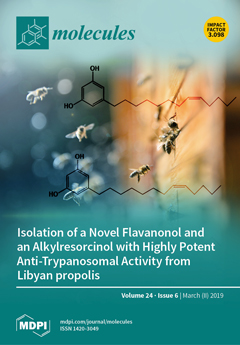The transcellular transport and metabolism of eight green tea catechins (GTCs) were studied in Caco-2 monolayers, with the aim of investigating the effect of cis–trans isomerism on the membrane permeability and biotransformation of GTCs. The results showed that the catechin stereochemistry significantly affects the efflux transport rather than the absorption transport in the Caco-2 monolayers. The trans catechins showed a better transcellular permeability than their corresponding cis (epi) catechins in the efflux transport, as the efflux amount of trans catechins were all significantly higher than that of the cis (epi) catechins at each concentration and each time point tested. Moreover, the relative contents of the (+)-catechin (C)-
O-sulfate, (+)-gallocatechin (GC)-
O-sulfate, (−)-catechin gallate (CG)-
O-sulfate, and (−)-gallocatechin gallate (GCG)-
O-sulfate in the efflux transport were 2.67, 16.08, 50.48, and 31.54 times higher than that of the (−)-epicatechin (EC)-
O-sulfate, (−)-epigallocatechin (EGC)-
O-sulfate, (−)-epicatechin gallate (ECG)-
O-sulfate, and (−)-epigallocatechin gallate (EGCG)-
O-sulfate, respectively. It indicated that more metabolites were observed after the transcellular efflux of trans catechins. Furthermore, after two hours of incubation, the GTCs could significantly increase the expression of multidrug resistance-associated protein 2 (MRP2) and breast cancer-resistance protein (BCRP), and decrease the expression of
P-glycoprotein in the Caco-2 cells. The regulation of GTCs on P-glycoprotein, MRP2, and BCRP could also be significantly influenced by the chemical and dimensional structure. In a conclusion, catechin stereochemistry significantly affects the transport and metabolism of GTCs when refluxed in the Caco-2 monolayers.
Full article






